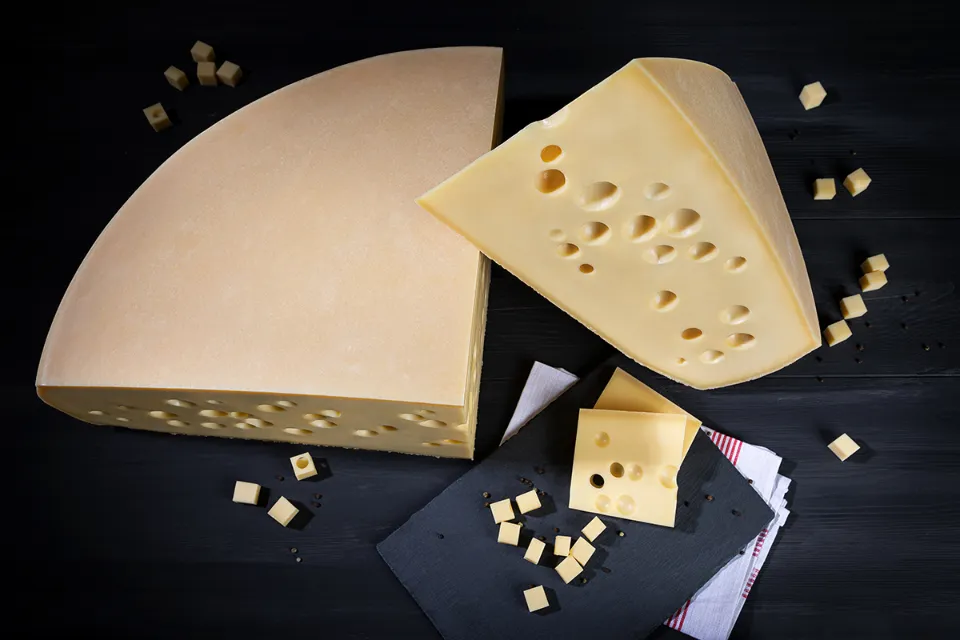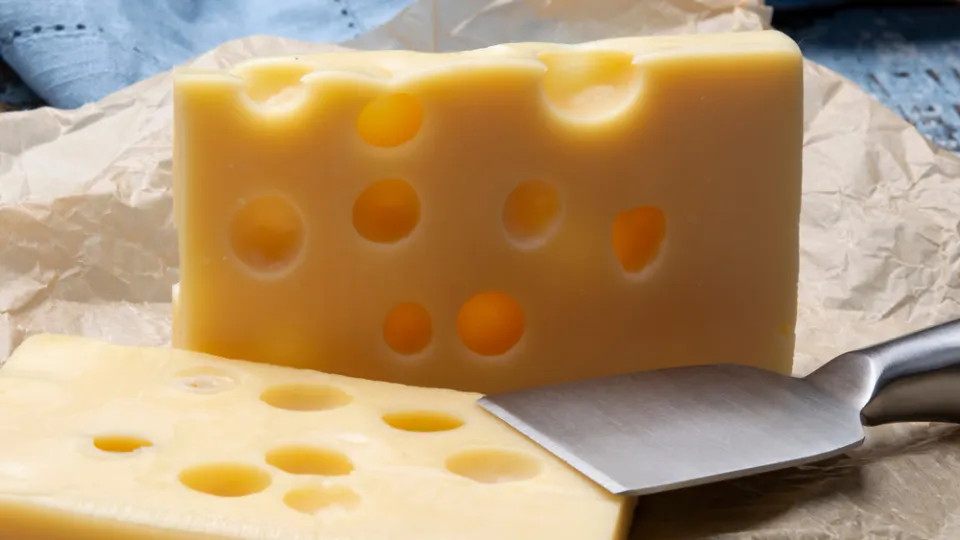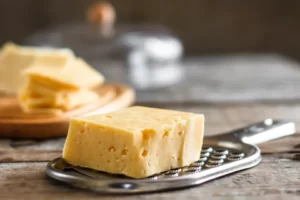Emmentaler cheese is a type of semi-hard Swiss cheese made from cow’s milk. Like other Swiss cheese, it also has “eyes” formed during the fermentation process.
The flavor of Emmentaler cheese varies from mild and buttery to fruity and strong depending on the maturity of it.
Here is some more information about Emmentaler cheese.

What is Emmenthal Cheese?
Swiss Emmenthal production can be traced back to the 13th century in the valley of the river Emme in the Swiss canton or region of Bern, the oldest cheese in Switzerland, which is regarded as an essential component of Swiss culture. Emmenthal produced in the region’s creameries benefits from appellation d’origine protégée (AOP) or protected designation of origin (PDO) status, requiring it to be made from fresh raw (unpasteurized) milk from cows fed exclusively on grass and hay within the designated areas of production, with no additives or genetically modified components.
A semihard, smooth cheese made from cow’s milk, Emmenthal is also referred to as Emmental, Emmentaler, and Emmenthaler. The rind is hard and inedible, and the body is firm and dense. It has a variety of flavors, from buttery and silky to nutty, fruity, and robust. Emmenthal that is young or classic has been aged for at least four months and is mild and fruity.
Why It is Called Emmenthal Cheese?
Emmenthal is derived from the river Emme and the German word tal or “valley.” French, German, and Italian are among the four national tongues and cultures of Switzerland. Emmentaler, Emmental, and Emmenthaler are all correct names for cheese and can reflect the local language or dialect. Emmenthal is the name given to cheese made outside of Switzerland.

How Emmentaler is Made
Just west-central Switzerland produces authentic Emmentaler. The canton of Bern is where the cheese originated.
Production starts on the hillsides and meadows that are encircled by freshwater basins. Local cows graze on the hay and grass on these pastures, which is how Emmentaler gets its distinctively sweet flavor. Large copper cauldrons containing raw milk are stirred to mix in natural whey and rennet, which causes curd to form. Whisks are used to divide the curd, and the excess whey is drained off before the curd is put into molds. After brining, the molds are aged. In order to develop recognizable eyes in the body, temperatures are kept warm. The cheese develops the characteristics of Emmentaler after at least two months.
True Emmentaler cheese is unpasteurized and flavorful because it contains only raw milk from pasture. The majority of versions are entirely free of gluten because there are never any artificial flavors or fillers added. Since Emmentaler is produced in both vegetarian and non-vegetarian varieties, be sure to check the packaging for non-vegetarian ingredients.
Types of Emmentaler Cheese
The flavor of Reserve Emmenthal is nuttier and more potent because it has been aged for at least eight months. Additionally, Emmenthal that has been aged in caves for at least a year is more flavorful and complex. Swiss Emmenthal can be bought in well-stocked supermarkets or specialty shops for a moderate to expensive price, depending on how long it has been aged.

Uses of Emmentaler Cheese
Emmenthal has excellent melting qualities, making it perfect for cheese fondue or any dish that calls for melted cheese, including gratins and casseroles, grilled cheese sandwiches, pasta, and egg dishes. Additionally, it can be served on a cheese platter with fruit and nuts, layered into sandwiches, or eaten cold.
How to Storage Emmentaler Cheese
Put the cheese in a zip-top bag or a plastic container and wrap it in waxed or parchment paper to store it in the refrigerator. This will permit some airflow, but prevent the smell of cheese from filling the refrigerator. If any mold appears, carefully cut around it without touching it with your knife. For up to six weeks, menthal can be kept in the refrigerator. The flavor and texture won’t be significantly altered by freezing it for up to three months. For freezing, coarsely grate or tightly wrap hand-sized blocks in plastic wrap before storing them for up to three months in zip-close bags with all the air squeezed out. Before using the cheese, let it defrost in the fridge over night.
Substitutes for Emmentaler
Emmentaler continues to be a favorite among people of all ages despite being rarely imitated. You can get different flavors in your dish by combining cheeses with similar textures.
Gruyère is stronger in flavor and pairs well with dishes that call for Emmentaler. Although less fragrant, this cheese still has a ton of flavor and melts smoothly.
Swiss cheese resembles Emmentaler in terms of tastes and textures, and it has nutty undertones along with a dense yet soft body. The flavor profile is creamy with a sweet undertone.
Final Thoughts
Emmentaler is a semi-hard cow’s milk cheese from Switzerland that tastes nutty and buttery. Since it melts easily, cheese fondue frequently uses it. To replace it, we can use Gruyere or Swiss cheese.

Related Reading
All You Need to Know About Manchego Cheese
FAQs
Is Gruyere Cheese Same as Emmental?
Unlike Gruyère, Emmental has larger holes (representative of a classic Swiss cheese) and a buttery flavor making it perfect for casseroles and gratins.
Is American Swiss Cheese Emmental?
Appearance. Both cheeses are formed with naturally occurring holes (HINT: The size of the holes does not affect flavor!). Emmental is a semi-hard, yellow cheese. American Swiss is more pale and shiny.
Is Emmental Cheese Like Gouda?
Gouda cheese is a creamy cheese with a semi hard texture and a mild taste. As Gouda ages, it does become harder, but it is still such a delicious cheese and a great emmental cheese substitute. It’s wonderful on top of crusty bread and paired with light fruity wine.


